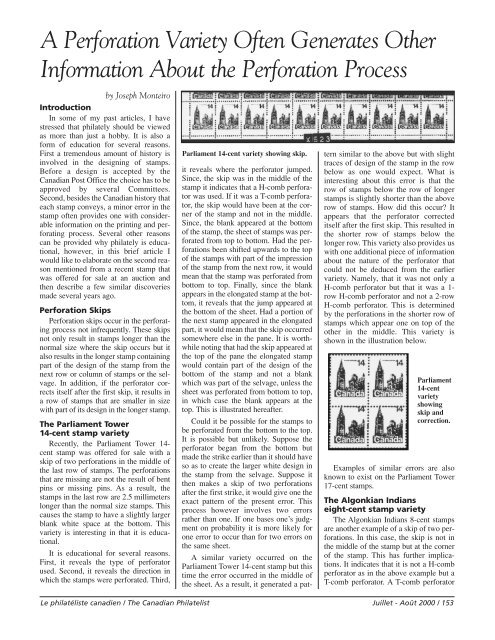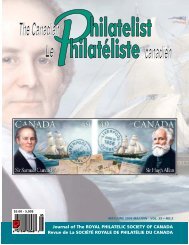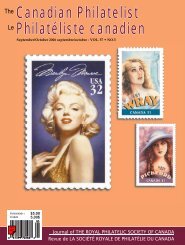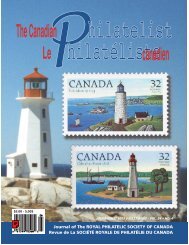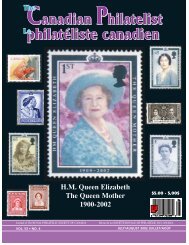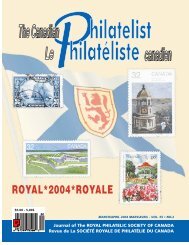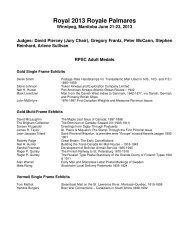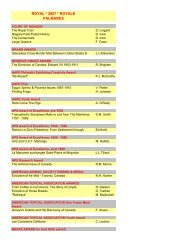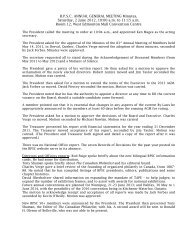Phil pages July-Aug-Final - The Royal Philatelic Society of Canada
Phil pages July-Aug-Final - The Royal Philatelic Society of Canada
Phil pages July-Aug-Final - The Royal Philatelic Society of Canada
You also want an ePaper? Increase the reach of your titles
YUMPU automatically turns print PDFs into web optimized ePapers that Google loves.
A Perforation Variety Often Generates Other<br />
Information About the Perforation Process<br />
by Joseph Monteiro<br />
Introduction<br />
In some <strong>of</strong> my past articles, I have<br />
stressed that philately should be viewed<br />
as more than just a hobby. It is also a<br />
form <strong>of</strong> education for several reasons.<br />
First a tremendous amount <strong>of</strong> history is<br />
involved in the designing <strong>of</strong> stamps.<br />
Before a design is accepted by the<br />
Canadian Post Office the choice has to be<br />
approved by several Committees.<br />
Second, besides the Canadian history that<br />
each stamp conveys, a minor error in the<br />
stamp <strong>of</strong>ten provides one with considerable<br />
information on the printing and perforating<br />
process. Several other reasons<br />
can be provided why philately is educational,<br />
however, in this brief article I<br />
would like to elaborate on the second reason<br />
mentioned from a recent stamp that<br />
was <strong>of</strong>fered for sale at an auction and<br />
then describe a few similar discoveries<br />
made several years ago.<br />
Perforation Skips<br />
Perforation skips occur in the perforating<br />
process not infrequently. <strong>The</strong>se skips<br />
not only result in stamps longer than the<br />
normal size where the skip occurs but it<br />
also results in the longer stamp containing<br />
part <strong>of</strong> the design <strong>of</strong> the stamp from the<br />
next row or column <strong>of</strong> stamps or the selvage.<br />
In addition, if the perforator corrects<br />
itself after the first skip, it results in<br />
a row <strong>of</strong> stamps that are smaller in size<br />
with part <strong>of</strong> its design in the longer stamp.<br />
<strong>The</strong> Parliament Tower<br />
14-cent stamp variety<br />
Recently, the Parliament Tower 14-<br />
cent stamp was <strong>of</strong>fered for sale with a<br />
skip <strong>of</strong> two perforations in the middle <strong>of</strong><br />
the last row <strong>of</strong> stamps. <strong>The</strong> perforations<br />
that are missing are not the result <strong>of</strong> bent<br />
pins or missing pins. As a result, the<br />
stamps in the last row are 2.5 millimeters<br />
longer than the normal size stamps. This<br />
causes the stamp to have a slightly larger<br />
blank white space at the bottom. This<br />
variety is interesting in that it is educational.<br />
It is educational for several reasons.<br />
First, it reveals the type <strong>of</strong> perforator<br />
used. Second, it reveals the direction in<br />
which the stamps were perforated. Third,<br />
Parliament 14-cent variety showing skip.<br />
it reveals where the perforator jumped.<br />
Since, the skip was in the middle <strong>of</strong> the<br />
stamp it indicates that a H-comb perforator<br />
was used. If it was a T-comb perforator,<br />
the skip would have been at the corner<br />
<strong>of</strong> the stamp and not in the middle.<br />
Since, the blank appeared at the bottom<br />
<strong>of</strong> the stamp, the sheet <strong>of</strong> stamps was perforated<br />
from top to bottom. Had the perforations<br />
been shifted upwards to the top<br />
<strong>of</strong> the stamps with part <strong>of</strong> the impression<br />
<strong>of</strong> the stamp from the next row, it would<br />
mean that the stamp was perforated from<br />
bottom to top. <strong>Final</strong>ly, since the blank<br />
appears in the elongated stamp at the bottom,<br />
it reveals that the jump appeared at<br />
the bottom <strong>of</strong> the sheet. Had a portion <strong>of</strong><br />
the next stamp appeared in the elongated<br />
part, it would mean that the skip occurred<br />
somewhere else in the pane. It is worthwhile<br />
noting that had the skip appeared at<br />
the top <strong>of</strong> the pane the elongated stamp<br />
would contain part <strong>of</strong> the design <strong>of</strong> the<br />
bottom <strong>of</strong> the stamp and not a blank<br />
which was part <strong>of</strong> the selvage, unless the<br />
sheet was perforated from bottom to top,<br />
in which case the blank appears at the<br />
top. This is illustrated hereafter.<br />
Could it be possible for the stamps to<br />
be perforated from the bottom to the top.<br />
It is possible but unlikely. Suppose the<br />
perforator began from the bottom but<br />
made the strike earlier than it should have<br />
so as to create the larger white design in<br />
the stamp from the selvage. Suppose it<br />
then makes a skip <strong>of</strong> two perforations<br />
after the first strike, it would give one the<br />
exact pattern <strong>of</strong> the present error. This<br />
process however involves two errors<br />
rather than one. If one bases one’s judgment<br />
on probability it is more likely for<br />
one error to occur than for two errors on<br />
the same sheet.<br />
A similar variety occurred on the<br />
Parliament Tower 14-cent stamp but this<br />
time the error occurred in the middle <strong>of</strong><br />
the sheet. As a result, it generated a pattern<br />
similar to the above but with slight<br />
traces <strong>of</strong> design <strong>of</strong> the stamp in the row<br />
below as one would expect. What is<br />
interesting about this error is that the<br />
row <strong>of</strong> stamps below the row <strong>of</strong> longer<br />
stamps is slightly shorter than the above<br />
row <strong>of</strong> stamps. How did this occur? It<br />
appears that the perforator corrected<br />
itself after the first skip. This resulted in<br />
the shorter row <strong>of</strong> stamps below the<br />
longer row. This variety also provides us<br />
with one additional piece <strong>of</strong> information<br />
about the nature <strong>of</strong> the perforator that<br />
could not be deduced from the earlier<br />
variety. Namely, that it was not only a<br />
H-comb perforator but that it was a 1-<br />
row H-comb perforator and not a 2-row<br />
H-comb perforator. This is determined<br />
by the perforations in the shorter row <strong>of</strong><br />
stamps which appear one on top <strong>of</strong> the<br />
other in the middle. This variety is<br />
shown in the illustration below.<br />
Parliament<br />
14-cent<br />
variety<br />
showing<br />
skip and<br />
correction.<br />
Examples <strong>of</strong> similar errors are also<br />
known to exist on the Parliament Tower<br />
17-cent stamps.<br />
<strong>The</strong> Algonkian Indians<br />
eight-cent stamp variety<br />
<strong>The</strong> Algonkian Indians 8-cent stamps<br />
are another example <strong>of</strong> a skip <strong>of</strong> two perforations.<br />
In this case, the skip is not in<br />
the middle <strong>of</strong> the stamp but at the corner<br />
<strong>of</strong> the stamp. This has further implications.<br />
It indicates that it is not a H-comb<br />
perforator as in the above example but a<br />
T-comb perforator. A T-comb perforator<br />
Le philatéliste canadien / <strong>The</strong> Canadian <strong>Phil</strong>atelist Juillet - Août 2000 / 153


